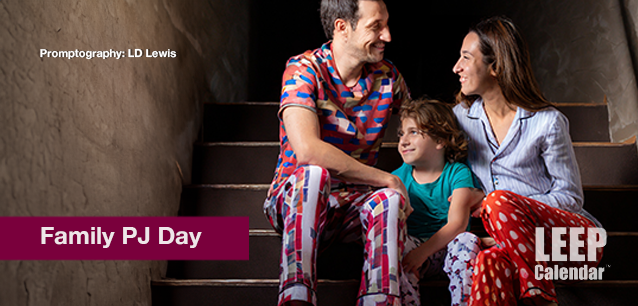 AD
AD
Today is: August 04
Scroll to explore events active on this date.
LEEP INK FEATURES

May Blooms: Events in May 2025
Along with October, May is one of the most densely packed months of the year. It's before the summer humidity and the last whole month of the school year. The weather is warming in t...

Sweet June 2025
The solstice on the 20th marks the onset of summer (Northern Hemisphere) or winter (Southern Hemisphere). Many people, particularly in Europe, North America and Asia, will be embarking o...

Events in April 2025
Spring has sprung in the north, and the first hints of Autumn are on the horizon in the south. April is the month spring (or fall) gets underway, and it is filled with religious celebrations, including the Mu...
About National Family PJ's Day
United States
Ends: Nov 14, 2025
DESCRIPTION:
National Family PJ's Day began in 2019. Its champion, Soma, is an American apparel company.
National Family PJ's Day falls during Sleep Comfort Month, primarily focusing on bringing families together in a cozy, relaxed setting. The emphasis is on spending quality time with family members while enjoying the comfort of pajamas, affectionately known as PJs or jammies.
HISTORY OF PAJAMAS
The history of pajamas, a garment synonymous with comfort and relaxation, spans across cultures and centuries. Pajamas, known today as casual wear for sleeping or lounging, originated in South Asia, specifically in India and the surrounding regions.
The word "pajama" comes from the Hindi "pae jama" or "pai jama," meaning leg clothing, and was traditionally used to describe loose, lightweight trousers fitted with drawstring waistbands, worn by many in India, Iran, Pakistan, and Bangladesh. The loose-fitting garments provided comfort in the hot and humid climate, garnering admiration from British colonists in India during the 18th and 19th centuries for their comfort, leading to their adoption, particularly as sleepwear.
Once the British introduced pajamas to the Western world, there was a significant shift in sleepwear fashion. Until then, people primarily slept in nightshirts and nightgowns. By the late 19th and early 20th centuries, pajamas had become a popular sleepwear choice for both men and women in the West, appreciated for their practicality and comfort.
The design of pajamas evolved, incorporating various materials like cotton, silk, and flannel. The traditional pajama set, consisting of a button-up shirt and trousers, became a staple, often adorned with piping, collars, and cuffs. This style gained immense popularity in the 20th century, partly due to its depiction in Hollywood films and as a symbol of leisure in the Western world.
During the 20th century, pajamas were also considered appropriate for lounging or informal home entertaining, blurring the lines between sleepwear and casual wear. The concept of "pajama dressing" emerged in fashion, with designers creating pajama-inspired styles suitable for wear outside the home. Playboy Magazine founder Hugh Hefner was notorious for spending the day and running his companies in silk pajamas.
The evolution of pajamas reflects broader cultural shifts, including changes in attitudes toward leisure, comfort, and fashion. From their origins in South Asia to their adoption and adaptation in the West, pajamas have become ubiquitous in modern attire, representing a blend of comfort, practicality, and style.
VIDEOS
SUPPORTING DOCUMENTS
Currently, this event does not have supporting documents.
ADDITIONAL IMAGES
Currently, this event does not have supporting images.
Where would you like to go now?
 AD
AD


/footer-logo.svg)
